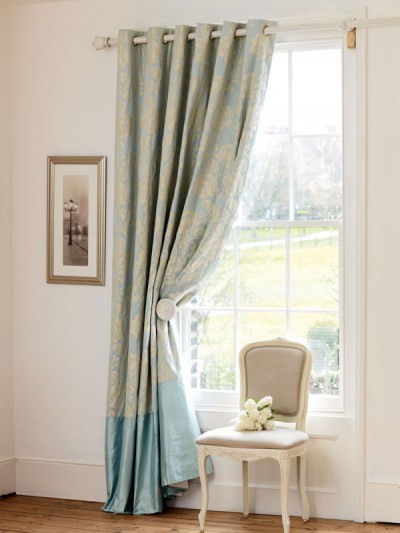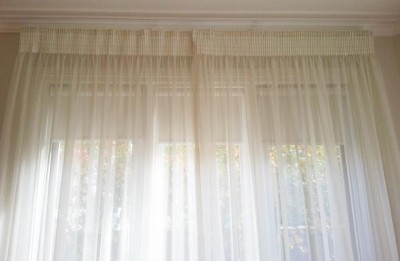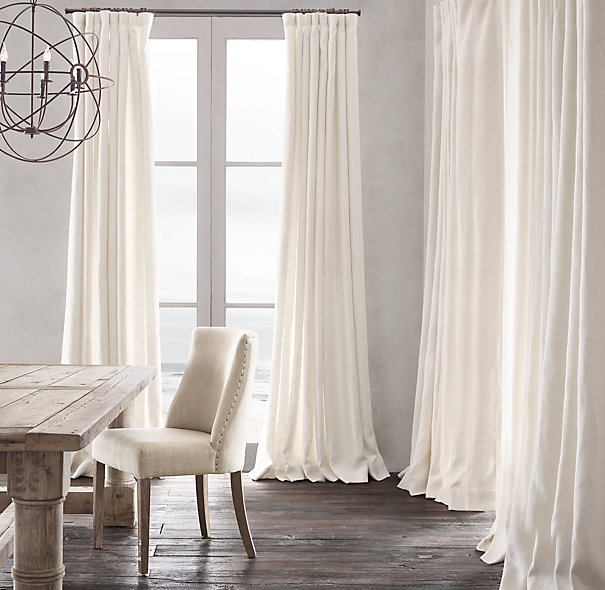May 5, 2016 (Gephardt Daily/Houzz.com) — Curtains are much more than just window dressing. They can form the basis of a room’s whole look and atmosphere, says How To website Houzz.com. Of course they’re practical too, offering privacy, warmth and energy-saving benefits. However, with so many fabrics, patterns and styles to choose from, it can take time to find the right curtains for your space. Start by following the buying advice of these experts.
Types of Curtains
Ready-made. These are an excellent easy update if you’re working with a smaller budget or a tight time frame. They come ready to hang straight from the shop, and you won’t need to wait for makers and fitters. You’ll have to take your own window measurements, but many retailers offer guidance on this.
There are drawbacks, however. “Because they’re available in limited size options, ready-made curtains may not be a perfect fit for your window,” Amanda Duffield of Unidrape Blinds & Interiors says. “You may have to position a track or pole to suit the closest curtain size available.” Duffield also warns that the linings used for ready-made curtains are generally of a lower quality than those of made-to-measure.

Made-to-measure. Opting for custom curtains lets you tailor the material, pattern, color and style to your own requirements. “Ready-made curtains come in standard sizes, while windows don’t — especially in period or traditional homes, where they can be a variety of shapes and sizes,” Sarah Quilliam of Hillarys says. “With a made-to-measure service, you can be confident your curtains will be the best fit for your window.”
In addition, having a wider choice of fabrics means you’ll have a greater scope in putting your own stamp on the design. “You can add in extra features too, such as additional lining, tiebacks and headings for a bespoke look that meets your needs,” Quilliam says.
A potential disadvantage of custom curtains is that you can expect a lead time of two to three weeks, depending on the availability of the fabric. Also, as Duffield points out, “although in the long term made-to-measure curtains offer value for money, they’re a more considerable initial outlay than ready-made ones.” So look for designs that won’t become dated and that you won’t tire of, to justify the higher cost.
Never skimp on the making part of your custom curtains. If cost is a factor, choose a less-expensive fabric and, regardless of your budget, look for quality in the service you get from your maker.
“Always use a recommended curtain-making service, which will send a trained staff member to your home to measure up and give advice on the best style to suit your windows,” designer Mary Gannon says.
A curtain’s heading is the way in which it’s attached to the pole or track. It can have a big impact on the look of your curtains.
Eyelets. These have an unfussy, contemporary aesthetic, with regular, even pleats. The curtain will need little space on either side of the window to stack back.
French or pinch pleats. These headings are made by joining three pleats together at the top of the curtains. They are pricier than other options, because they’re more labor-intensive to make, but Quilliam says they’re worth the extra money.
“Pinch pleats give a more tailored finish, with the curtain falling into elegant folds that can easily be dressed for a slightly more formal look — ideal for living rooms,” she says.

Pencil pleats. These are narrow, single pleats formed in neat folds. “Pencil pleats are less structured than pinch pleats and have an attractive, uniform gathered edge that works particularly well in more casual situations, such as a home office or bedroom,” Quilliam says.
Blackout lining. Your curtains will not be complete without the right lining for your lifestyle. Blackout linings, for example, will block much of the light that would otherwise creep through closed curtains. “For [nighttime] workers, parents with babies and cinema rooms, blackout is an essential element,” Gannon says. “They also provide insulation, thus energy-saving benefits, as well as reducing noise from outside.”
Blackout curtains are a useful feature in other areas of the home too. For example, in living areas they can prevent glare on a TV or computer screen. “For total darkness, you could team blackout curtains and blinds together at one window,” Quilliam says.
Thermal lining. A lot of heat can be lost through windows and, with utility bills continuing to rise, thermal curtains will help you save money. “According to a recent survey by Kingfisher, Europeans are more concerned about energy prices than their mortgages or rent payments,” Quilliam says. “Fully lined curtains can help to prevent heat from escaping through windows, but for added coziness, consider a thermal lining.”
Sheer, or voile, drapes soften the overall appearance of a window, maximize natural light during the daytime and still offer privacy. They’re not lined, so they don’t take up much room when pulled back from the window, which also makes them ideal where space is at a premium.
Available in a range of fabrics, including cotton, silk and synthetic materials, sheers can be more cost-effective than traditional curtains. “Lots are available in wider widths, cutting down on the amount of making-up time needed,” Gannon says.
Sheers have health benefits, too. “They’re good for people who suffer from hay fever, as they can help to stop pollen entering a room,” Gannon says. “With the exception of silk, they can be cleaned more regularly than standard curtains, which is a benefit to asthma and allergy sufferers.”
Most curtains can be dry-cleaned, but you may see some shrinkage — sometimes as much as 5 percent. Clean curtains only when really necessary, and always go to a recommended dry cleaner. Consider using the upholstery attachment of your vacuum cleaner too, for a quick refresh. Over time, this will minimize the need for dry cleaning.
Curtains are a big investment for most people. Think long-term and whether you’re going to tire of a color or design. “Before committing, borrow a returnable sample if available, or buy [a yard] and see it in your own light,” Gannon advises. “The color can change dramatically depending on light levels.”
Think too of the effect you want to create. “Linen — and in particular embroidered linen — is beautiful but will not, by its very nature, give a smooth, streamlined look, so if this is what you want, then avoid it,” Gannon recommends. “Consider the end result you’d like to achieve and discuss this with your designer, curtain maker or the fabric house. Once you’ve agreed on a fabric and it’s been made up, there’s no going back, so take time to do your homework.”







My wife really wants to find different drapes for our living room, but wasn’t sure what style to get. I really like that you say to look at made to measure. It would be nice to get them custom made for our home.
In your article, you stated that opting for custom curtains lets you tailor the material, pattern, color and style to your own requirements. My wife has been trying to find some decorations for the windows in our house. I wonder if these types of curtains can be installed for any type of window.
Derek, that’s a good point that custom curtains give you lots of options. I bet that can really help when you have a really specific design direction for your room. Did custom curtains end up working for you?